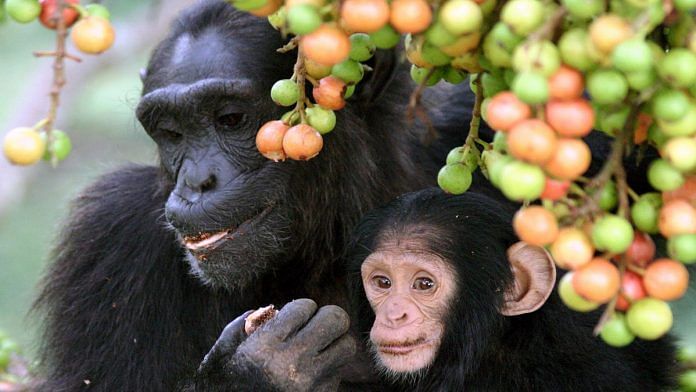Bengaluru: A chimpanzee’s grunt almost always means food, a ‘hoo’ is definitely a retort to a threat, and panted grunts are mostly submissive greetings. And according to a new study, chimpanzees can string together these sounds in varying combinations to produce “sentences” conveying different meanings.
These are the findings of an international group of researchers who observed adult chimpanzees at the Taï National Park in Africa’s Ivory Coast to understand semantic structures used by them while communicating with each other.
According to the study, the researchers — from France, Germany and Ivory Coast — found that the primates can combine 12 primary sounds to form 390 “words” or unique sequences, forming a precursor to language.
The study was conducted in two parts, in January-February 2019, and between December 2019 and March 2020. The findings, which have been peer-reviewed, were published Monday in the open-access journal Communications Biology.
The researchers studied 4,862 vocalisations made by 46 wild adult chimpanzees, spanning 900 hours of recordings. The 12 primary sounds they identified included grunts and hoos, which the chimps combined into groups to form phrases of varying meanings, the study says.
The combinations consisted of bigrams and trigrams — while bigrams are a sequence of two of the primary sounds, trigrams are recombinations of single-unit sounds and bigrams.
Chimpanzees are considered to be one of the more cognitively developed species on the planet. In February, another study published in the peer-reviewed scientific journal Current Biology showed that chimpanzees sometimes use insects to treat their wounds as well as those of their friends, behaviour that may be a sign of altruism in the species.
The authors of the latest study suggest that the rules they observed the chimpanzees using during vocalisations have structural complexity capable of generating new meanings by recombining sounds, and emphasised that further research is needed to understand the meaning of various sequences of vocalisations.
Also Read: From body to brains and personality, here’s how humans will look like after 10,000 years
Bigrams and trigrams
In their study, the authors classified sounds made by chimpanzees into 12 basic units — grunt, hoo, bark, scream, whimper, pant, panted grunt, panted hoo, panted bark, panted scream, panted roar, and non-vocal sounds like blowing a raspberry or smacking of the lips.
Sounds with and without panting were found to be used in different contexts — for example, single grunts were used when eating, while panted grunts were emitted during submissive greetings, a single ‘hoo’ was emitted towards a threat, while panted ‘hoos’ were used in interactions with other chimpanzees.
According to the researchers, chimpanzees can combine two of these 12 main sounds to form bigrams. Some sounds had the propensity to occur before or after some others, while some bigrams occurred much more frequently than others. These bigrams were also recombined with other sounds to form trigrams or three unique units of sound combined together. For example, a trigram sequence could have a ‘panted hoo’, followed by a grunt-bark bigram, followed by a non-panted ‘hoo’.
The authors set about analysing three aspects of vocal communication — flexibility, or if different sounds can be combined with other sounds; ordering, or if sounds can be produced in different orders to change meaning or context; and recombination, or whether groups of combined sounds can further recombine to form longer sequences.
The findings show strong evidence regarding the use of structurally complex syntactical vocalisations, with the ability to convey new meanings, according to the authors.
The ability to sequence vocalisations exists in 31 “non-human primate species”, although longer sequences are formed in communication by great apes, namely, gorillas, chimpanzees, bonobos and orangutans, the authors further wrote in their study.
Chimpanzee intelligence
The intelligence of chimpanzees has been the subject of research for several decades. For example, Washoe, the female chimpanzee, was the first non-human to learn how to communicate using American Sign Language (ASL), and Nim Chimpsky, who was born in the 1970s, was subjected to an experiment at Columbia University to ascertain whether language is innate.
The world’s foremost authority on chimpanzees is British primatologist Jane Goodall, who has studied the animals for over six decades. Initially criticised for being too anthropomorphic, her work has revealed how similar chimpanzee behaviour is to that of humans. Goodall extensively documented a four-year long “war” among chimpanzee communities in Tanzania in the 1970s.
However, the extent of primate intelligence is as yet unquantified, as is the extent of their communication ability.
While chimpanzee sounds could be a precursor to language, more research is needed to determine what the meaning of the sounds chimps make is, and how capable they are of expanding their vocabulary, according to the authors of the new study.
(Edited by Gitanjali Das)
Also Read: Mysterious diseases in chimpanzees at Sierra Leone sanctuary linked to bacteria






